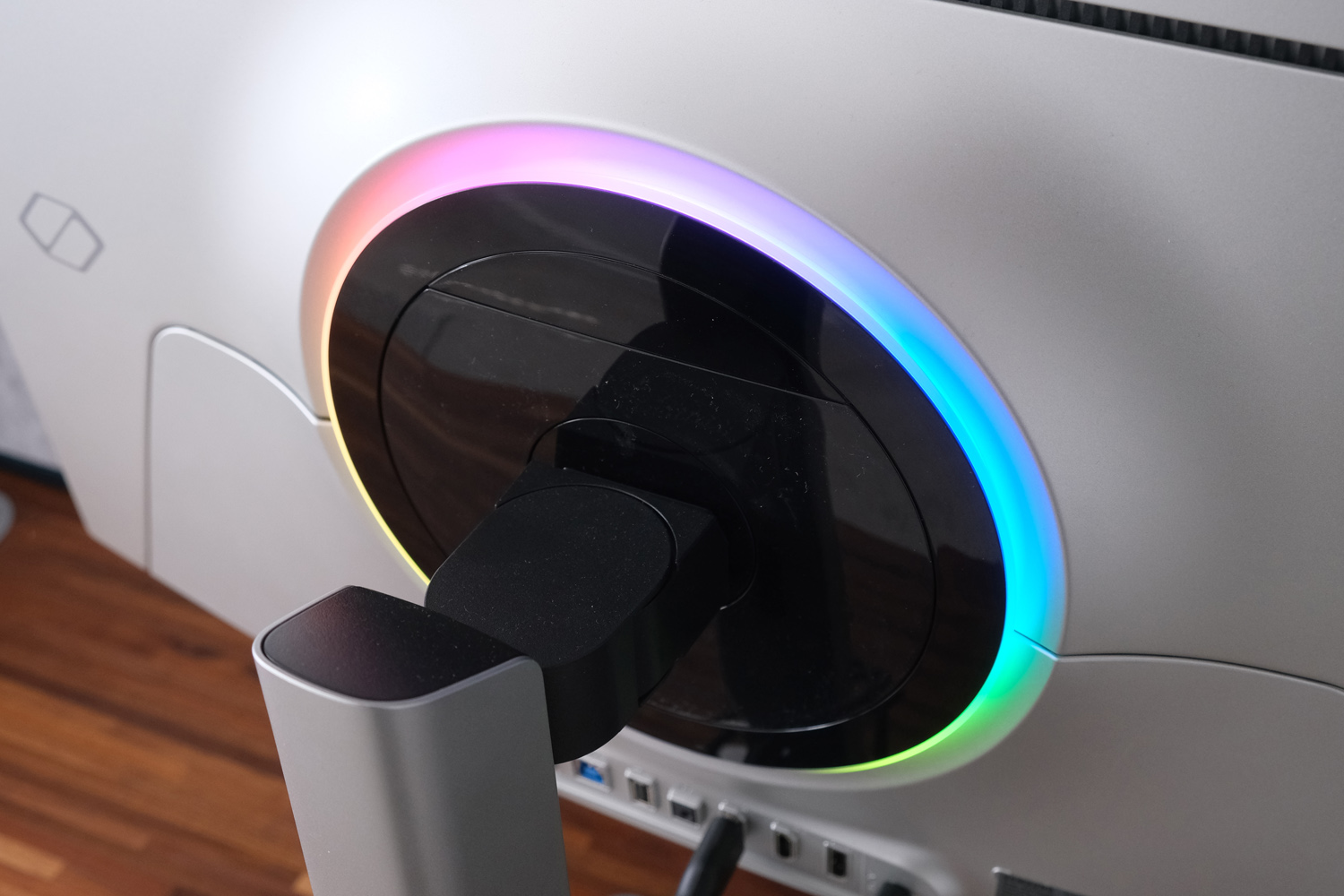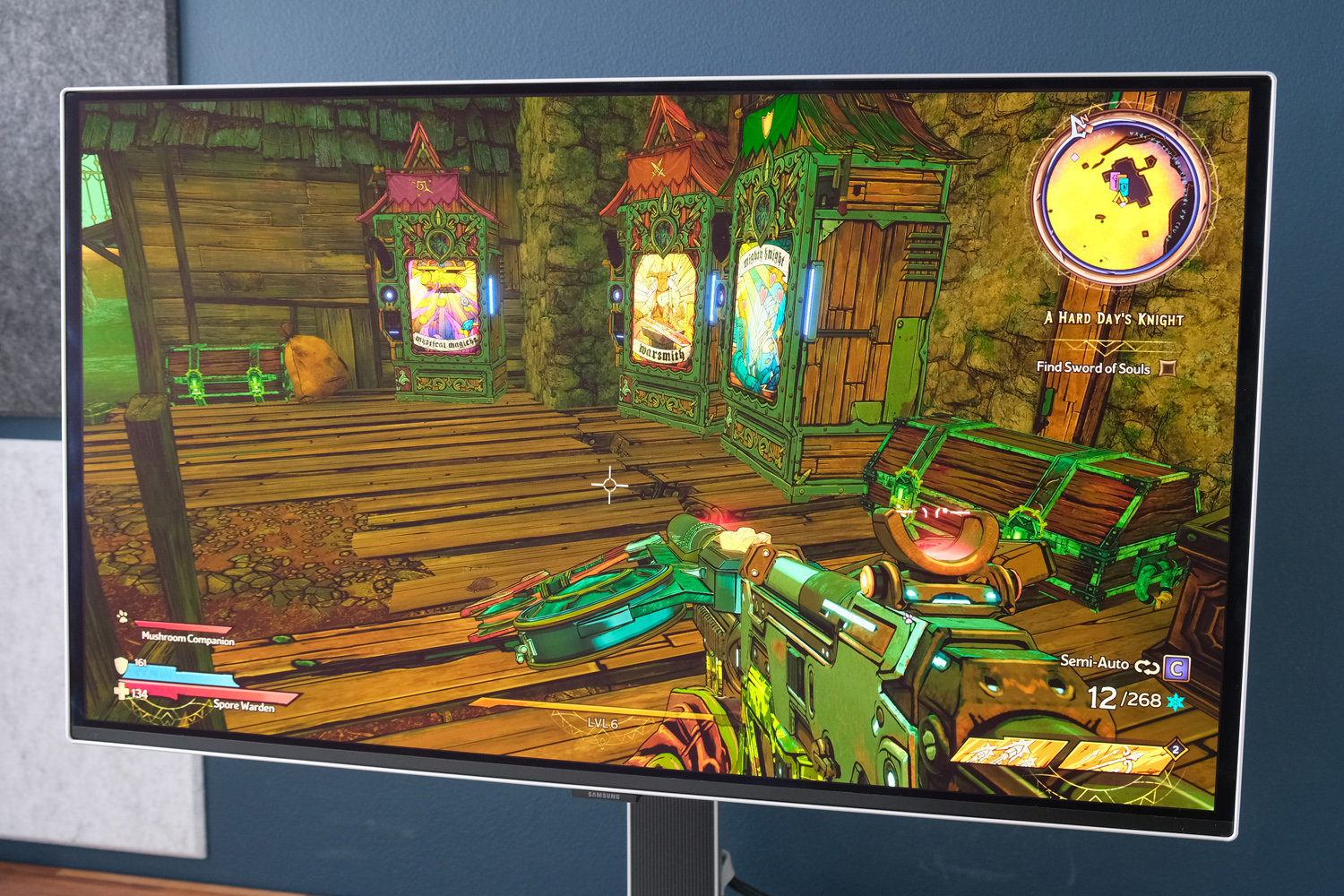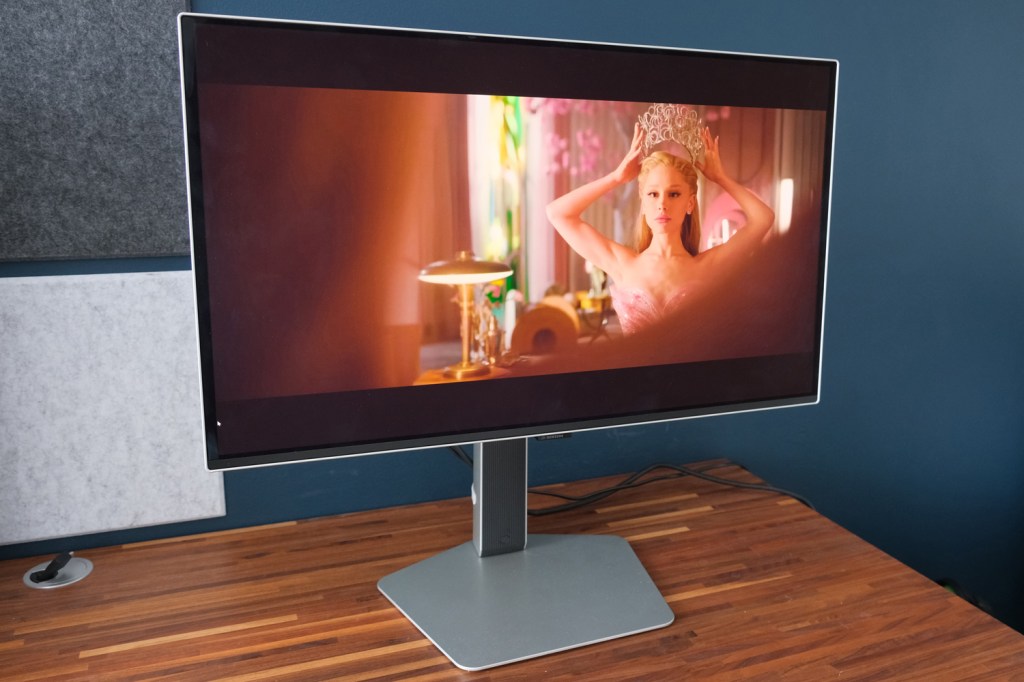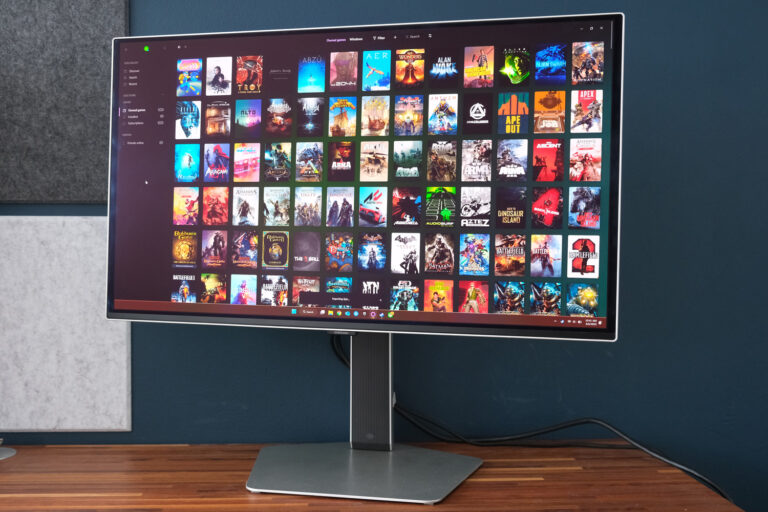Introduction
So you’ve just slapped down more than a mortgage payment for an RTX 5090 graphics card and your gaming PC can finally run every game under the sun at maximum details – but now your gaming monitor is the cork in the bottle. Samsung’s Odyssey G81SF will get those frames flowing again, with a 4K resolution and 240Hz refresh rate. Yet at 27in, it doesn’t demand excessive amounts of desk space.
The step up from the Odyssey OLED G6 squeezes even more pixels into its quantum dot OLED panel, so should have it bested for detail, and the blistering frame rate should keep esports gamers happy. It continues Samsung’s run of monitors that are drop dead gorgeous, too.
At launch this was a mighty pricey monitor, setting you back $1299/£1149. The Alienware AW2725Q was considerably easier on your bank balance. Things have changed a little since, with Samsung selling it directly for a much more competitive $1049/£899. Does that make it worth everyone’s attention, and not just those with flagship-grade GPUs?
Design & build: from the future
Samsung’s monitors all have a minimal, sci-fi vibe, but the OLED models take that to extreme by being so unbelievably slim. I’m still in two minds about the silver frame, which makes it more obvious where the panel begins and ends than the minuscule black trim seen on LG’s 32GS95UE, but honestly once the screen flickers into life you won’t notice – it’s that gorgeous.
Somehow the firm has also managed to squeeze a heat pipe cooling system inside the slender chassis, which Samsung says will help prevent screen burn-in over time. It’s smart enough to adjust the brightness based on heat levels, and recognise static elements like logos and taskbars. That bodes well for long-term ownership – something early OLEDs weren’t great at.
Building the stand is the job of mere seconds, needing no screwdriver. A twist here, a clip there, and you’re good to go. The upright piece is is plastic around a metal core, while the flat piece (which you see the most of when sat in front of the screen) is metal. It’s lightyears ahead of black plastic rivals for luxury feel. I rarely move my monitor, but those who do will appreciate how light it is.
It doesn’t look it, being so slim, but the stand is impressively sturdy and very adjustable. It tilts, swivels, and has a good amount of height adjustment, plus you can rotate the whole thing 90-degrees if you want a portrait-oriented display. Naturally it plays nicely with VESA mounts, too.
Samsung’s cable management is still pretty basic, with just a single rubber strap at the lower rear part of the stand to keep cables at bay. If your desk sits flush to the wall, there’s no way to hide wires entirely. There is at least room for every cable you could possibly plug into the panel, though.
Features & connectivity: the minimalist approach

Stepping up from the lower resolution G6 to the 4K Odyssey G8 doesn’t buy you much in the way of extra features. Beyond the different panels, the spec sheets are largely identical.
That means you still aren’t getting any built-in speakers. My Windows PC offered to pipe audio to the screen when hooked up over HDMI, but doing so just met me with silence. The volume controls built into the onscreen menus just control any headphones connected through the 3.5mm port at the back.
This is also where you’ll find the single DisplayPort 1.4 and two HDMI 2.1 ports. These both use Digital Stream Compression to reach 4K at 240Hz, which shouldn’t be an issue if your PC’s graphics card isn’t ancient – it’s visually lossless tech. And if your GPU is old enough to draw its pension, it has no chance of gaming at that resolution and refresh rate anyway.
All three connections support AMD Freesync Premium Pro rather than Nvidia G-Sync, but AMD’s tech doesn’t care what graphics card you have; either way you’re getting tear-free gaming. There’s VRR support for console players too, though PlayStation and Xbox each cap out at 120Hz.
There’s also a single upstream USB-B connection and two USB-As for hooking up peripherals. USB-C doesn’t get a mention. I get why: Samsung would need to support Thunderbolt 5 or USB4 V2 for a laptop to run at the Odyssey G8’s native resolution and refresh rate, which would surely bump the price up even further.
I’m glad Samsung kept its Infinity Core lighting at the rear; the colour-changing LED ring softly illuminates whatever’s behind the monitor, with a bunch of different patterns to pick from through the menus. The lights could be a little brighter – they have the biggest impact when you’re gaming in the dark.
Interface: does the job

Unlike the older, larger 32in Odyssey OLED G80SD, the G81SF doesn’t get Samsung’s flashy Tizen-based smart UI (which is stuffed with apps and streaming services). Here you’re getting a far more basic monitor menu, navigated by the control stick on the back of the monitor. It wasn’t so keen to swallow my inputs as the Odyssey G6, so getting around never felt like a chore.
There’s not too much on offer here, with the main screen sensibly taking up just a portion of the screen so you can see what difference your settings tweaks make in real-time. You get the usual gamer-grade tools, like black level adjustment, adaptive sync, and a virtual aim point, and can pick one setting (from a Samsung-approved list) to assign to a quick shortcut on the control stick.
The picture-in-picture mode is a neat addition if you’ve got multiple devices hooked up at once, but it’s exactly that: you can’t split the screen for picture-by-picture, and are limited to a corner of the overall image.
Picture settings cover all the usual bases, with brightness, colour, contrast and sharpness and tint sliders as well as a handful of presets. You can get more granular with white balance, colour tone and gamma adjustment, plus a contrast enhancer and HDR tone mapping.
Picture quality: pristine – at a price

Stretching a 4K resolution over 27in guarantees the Odyssey G8 delivers a gloriously detailed and crisp image. It’s a noticeable step up from the G6’s 1440p. Sure, you can get pro-grade monitors aimed at creatives with even more pixels per inch, but for gaming this is about as good as it gets right now. Games consoles can output natively and beefy PC graphics cards can really flex their muscles.
You’ll need one if you want to play the latest titles anything close to the G8’s maximum 240Hz refresh rate. I’m using an RTX 4090, and there are now plenty of games that can’t manage 60fps at 4K with all the details cranked, let alone 240fps. That said, OLED screens are so much better at motion handling than LCD ones that even lower frame rates looked smooth and felt whip-crack responsive. The variable refresh rate tech makes all the difference when your hardware begins to struggle, and input lag is basically negligible. Playing Doom The Dark Ages with HDR enabled and all settings cranked on this monitor is a transformative experience.
That’s partly down to how impactful colours look on this QD-OLED screen. With no white sub-pixel diluting down each hue, as is the case with W-OLED panels used by rivals like LG, the Odyssey G8 is deliciously vibrant. That’s not to say Samsung has returned to its oversaturated OLED heyday, though. There’s real nuance here, especially in the shadows of darker scenes. It helps that contrast is practically infinite. Colour coverage is spot on, with 99% DCI-P3. Tiny Tina’s Wonderlands absolutely pops with vivid shades; it’s a treat for the eyes.
VESA has given the G81SF its DisplayHDR True Black 400 seal of approval, and Samsung has brought dynamic HDR tone mapping to boost highlights on compatible content with the smallest reduction to gradation. The former is an indication this screen doesn’t get blindingly bright, and SDR content is unsurprisingly dimmer, but that doesn’t mean it’s lacking for daily use. I was happy to work and play with the brightness slider sat at 50%.
The glare-free screen coating does a fantastic job of diffusing light reflections; I had no issues working on it next to a window on the brightest of days. While OLED black levels are of course second to none – and have no light bloom to content with like a mini-LED monitor – I still preferred to game with the blinds drawn, as the anti-glare finish can’t work miracles against direct sunlight.
Samsung Odyssey G8 G81SF verdict

If you’re after a smaller screen that still has all the visual bells and whistles, the Odyssey G8 G81SF is an excellent choice. Picture quality is fantastic, and the screen itself is quite the looker. 4K at 240Hz isn’t for the weak, though, so you’ll need a top-spec gaming rig to make the most of it.
Should your hardware not cut the mustard, the more affordable Odyssey OLED G6 could be the better buy. Its 1440p resolution isn’t quite as future-proof, but the styling and feature set are otherwise an exact match. And if you manage to find the older 32in G80SD at a discount it’s still very much worth a look, on account of its larger panel and Tizen smarts.
For no-frills gaming greatness, however, the G81SF is tough to beat.
Samsung Odyssey G8 G81SF technical specifications
| Screen size | 27in, 16:9 |
| Resolution | 3840×2160 |
| Refresh rate | 240Hz, FreeSync Premium Pro/VRR |
| Response time | 0.03ms |
| Brightness | 250 nits (SDR) / 1000 nits (HDR) |
| HDR | DisplayHDR True Black 400 |
| Connectivity | 2x HDMI 2.1, 1x DisplayPort 1.4, 2x USB-A 3.1, 1x USB-B 3.1 |
| Dimensions | 612x554x264mm, 6.9kg (with stand) 612x354x49.2mm, 3.8kg (panel only) |
Read the full article here
